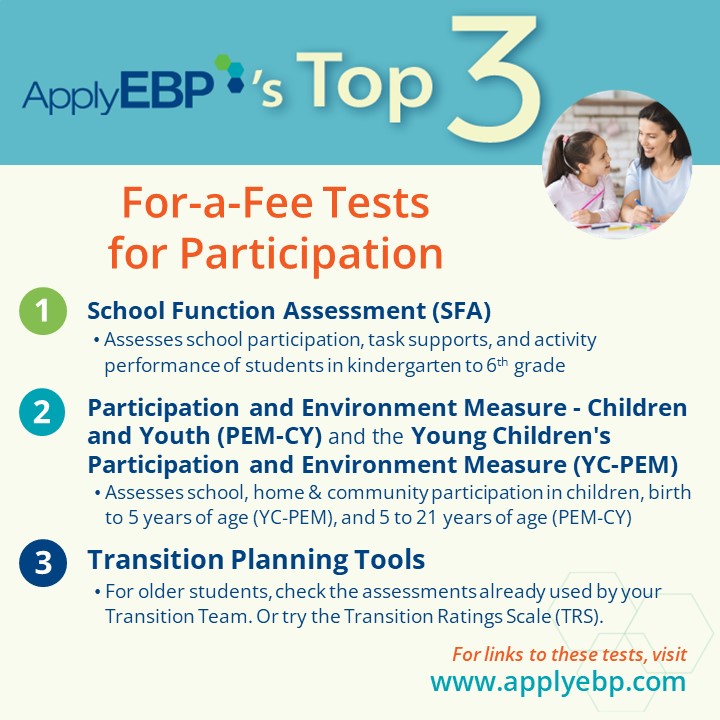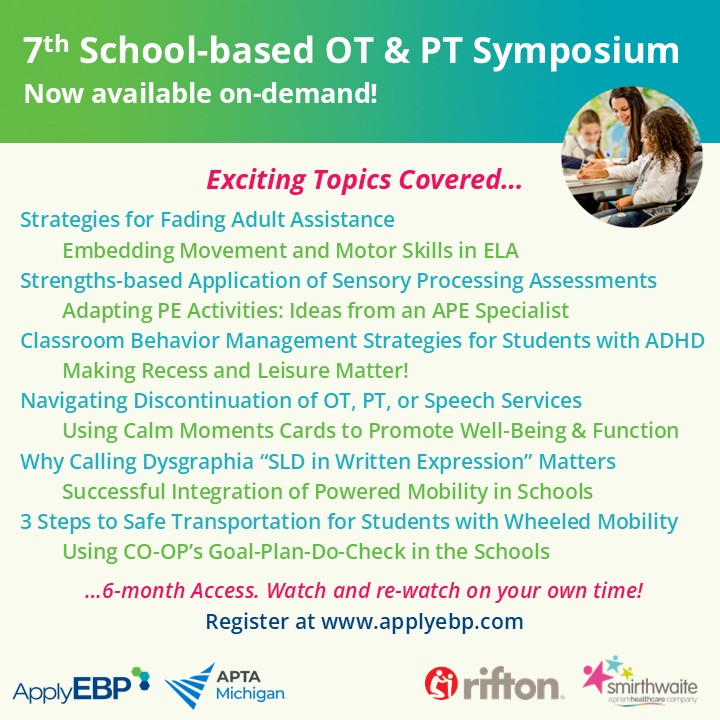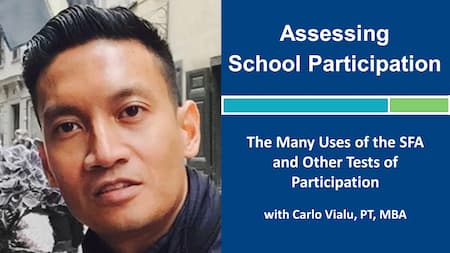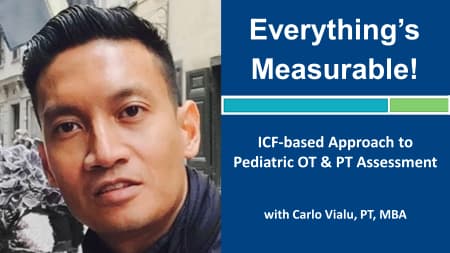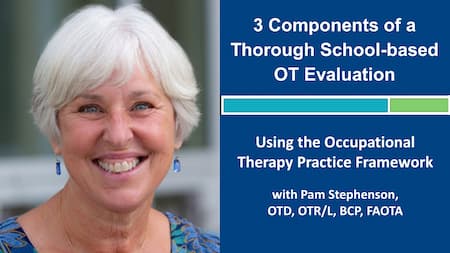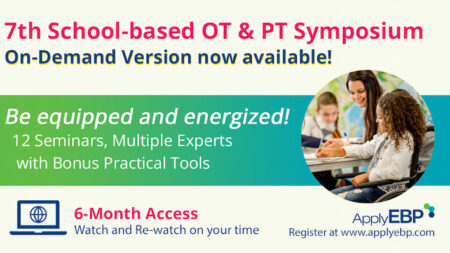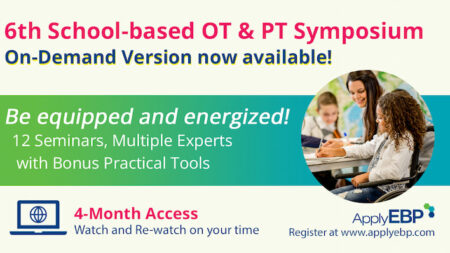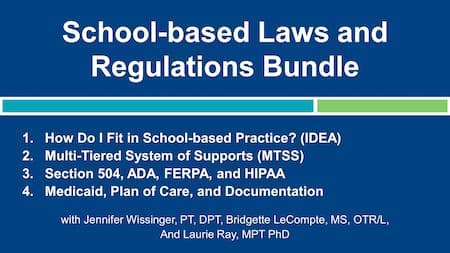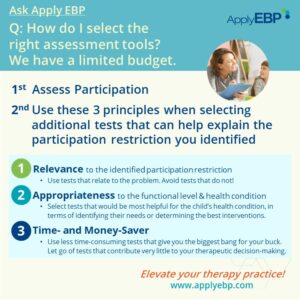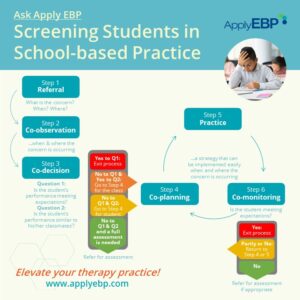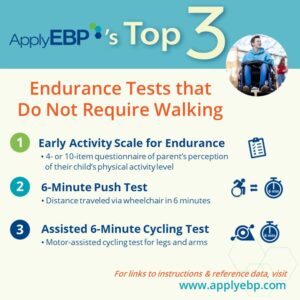Ask Apply EBP
Top 3 For-a-Fee Tests for Participation
Note that this article is part of a series of articles on assessment. If you have not done so, first, read this articles:
-
-
-
- Must-Have Test and Organizing Your School-based Assessment – discusses the 5 critical reasons for assessing participation first
- 3 Principles for Selecting Tests – discusses the 3 principles to use when selecting tests at the activity and body function & structure levels
-
-
Q: What are the best tests…for measuring participation?
In our article “Must-Have Test and Organizing Your School-based Assessment”, we emphasize the importance of initiating assessments by evaluating your pediatric client’s level of participation. Below, we have compiled our Top 3 favorites for-a-fee tests for participation. With these 3 in your toolkit, you have available to you participation tools that cater to individuals across different age groups, from 3 to at least 21 years old.
If you have limited funds to spend on assessment tools, you may also want to check out:
1. School Function Assessment (SFA)
The SFA is a 3-Part assessment tool that can measure school participation and activity performance, as well as task supports and accommodations.
-
-
- To purchase: Click here
- Best for: school-based practice, ages K-6
- Administration:
- Needs to be completed by an adult in the school that is familiar with the student’s participation and performance (often defined as at least 1 month of familiarity)
- Includes 3 sections: Part 1 – Participation; Part 2 – Task Supports; and Part 3 – Activity Performance.
- Part 1 is the Participation test. A short 6-item section that asks the respondent to rate the student’s performance in 6 areas of school function (Classroom, Playground/Recess, Transportation, Bathroom/Toileting, Transitions, Mealtime/Snack Time)
- Why we like this test:
- Part 1 is quick to administer, and can provide a broad rating of the student’s level of participation in the school.
- Part 1 is context-specific in that it refers to the student’s participation in the classroom that they attend, with the particular expectations of their particular teacher, and relative to the participation of their real-life peers. Therefore, it is NOT and DOES NOT get old (an often-mentioned critique about the SFA – see deeper discussion here).
- The rating is simple enough (from 1-6), and each level is meaningfully different from the others.
- What to note:
- The SFA is a standardized test.
- Real-life utility:
- You can use the ratings to:
- Determine areas of strength (i.e., those with the highest ratings)
- Identify and prioritize areas that need to be addressed (i.e., those with the lowest ratings), and
- Use the levels of participation to measure progress after interventions.
- Use the levels of participation to identify and narrow down relevant sections of SFA Part 3 that needs to be completed. For example, if Classroom participation is rated low, particularly in required academic tasks, then complete the “Task Behavior/Completion” section. If “Transition” participation is rated low, particularly on the stairs, then complete the “Up/Down Stairs” section.
- For more uses and hacks of the SFA, read the SeekFreaks article “Why I Still Like the SFA! SeekFreaks’ Fixes to 4 Big Complaints about the Test“
- You can use the ratings to:
- Limitation:
- It is often perceived as too old. However, there is only 1 item that is out of date (i.e., the use of floppy disc). As mentioned above, the Participation scale is timeless.
- It is often perceived as too long. As mentioned above, results of the Participation section can be used to narrow down the subsections of Part 3 to complete.
- Take caution using the cut-off scores on the summary page (last page of the form). Full independence is not an appropriate outcome or goal for many students with disabilities. Instead, use your knowledge of health conditions and your clinical reasoning to determine what are appropriate scores and outcomes for each child assessed.
-
2. Participation and Environment Measure – Children and Youth (PEM-CY) and the Young Children’s Participation and Environment Measure (YC-PEM)
The PEM-CY and YC-PEM are parent questionnaires that measure the child’s level of participation at home, in school, and the community, and rates how various areas of the environment support or hinder participation.
-
-
- To purchase: PEM-CY | YC-PEM
- Best for:
- They are both useful for school-based, home-based, and clinic-based practitioners.
- The PEM-CY is for 5-21 years old.
- The YC-PEM is for Birth-5 years old.
- Administration:
- Have the teacher complete the form by rating their level of agreement with each statement (1 = Disagree, 2 = Somewhat Disagree, 3 = Somewhat Agree, 4 = Agree).
- Why we like this test:
- They look at 3 important areas of participation: home, preschool/school and community.
- They both assess participation and the environment. So you know if you need to change the environment to promote better participation.
- The environment asks about social (in addition to the physical) environment, as possible barriers that you may need to impact.
- Ecologically valid, as included items are broad areas of function, for example “indoor play and games”, so it can be whatever indoor play and games that the child/family participates in.
- You just buy the PEM-CY and/or the YC-PEM one time, and you will receive a PDF of the manual and the forms that you can print out many times – so no need to keep on buying test forms.
- There’s a free PEM-CY version for parents to answer the items online.
- What to note:
- It is a standardized test. There are multiple published and ongoing research that reports on its reliability, validity, and utility.
- Real-life utility:
- Answer to the Participation section, Question C helps determine what the parent/guardian is motivated to address.
- Results can be used to determine which aspect of participation to improve on: the frequency of the participation (Question A), or the level of involvement in the activity (Question B).
- Responses to the Environment section can help determine barriers that need to be addressed, and facilitators that can be enhanced.
- Can be used as an outcome measure to measure impact of interventions.
- Limitation:
- Since the responders are parents/caregivers, they may have a hard time answering the “School” section with accuracy. But it’s a good way to start this conversation about the child’s school participation.
-
3. Transition Planning Tools
For older students, it is always best to check with your Transition Team. They are likely already using a transition planning tool, which by their nature often measures participation in 3 important areas of transition: education, employment, and independent living. Ask the team if you can help administer sections within your scope of practice, or whether you can help interpret results using your OT, PT, or Speech expertise. Here is an example of such tools:
Transition Ratings Scale (TRS)
The TRS is a “…transition assessment to support planning that meets the requirements of the Individuals with Disabilities Act.” (TRS website, accessed 2024)
-
-
- To purchase: Click here
- Why we like this test:
- It is cheap at $2 per test
- It looks at the 3 areas of post-school outcomes: post-secondary education, employment, and independent living
- What to note:
- They have 5 separate forms that can be completed by an educator and/or parent.
- TRS 1.0: educator-completed form for assessing “learners with mild disabilities”
- TRS 1.0 Parent Form
- TRS 2.0: educator-completed form for assessing “learners with moderate to significant needs for support”
- TRS 2.0 Parent Form
- TRS 3.0: educator- or parent-completed form for “for learners with pervasive and long-term needs for support”
- They have 5 separate forms that can be completed by an educator and/or parent.
-
Note that many assessment tools that may already be in your toolbox may contain Participation tests. For example, many items in the Developmental Assessment of Young Children (DAYC-2, birth to 5 years old) are about participation. Or, the Miller Function and Participation Scales (M-FUN), which has Home Observation and Classroom Observation Checklists with many participation items. In which case, use them until you have enough funds to purchase any of the above tools.
You may also want to use perform an Ecological Assessment. You can click here for Apply EBP’s Top 3 Components of an Ecological Assessment, and a free ecological assessment form (coming soon!).
If you would like to learn more about assessment, check out…
Find More Answers to Your Questions in Our...
Featured School
Symposium
7th Online School-based OT and PT Symposium - On-Demand Version
- Watch and re-watch on your own time
- On-Demand Version
- OTs, OTAs, PTs and PTAs
- $399-449
Featured Live
Workshop
6th Online School-based OT and PT Symposium - On-demand Version
- Watch and re-watch on your own time
- On-Demand Version
- OTs, OTAs, PTs and PTAs
- $399-449
Featured On-Demand
Webinar
Assessing School Participation
Featured Webinar
Bundle
School-based: Laws & Regulations
Have a question?
Submit here…
*Clicking submit will send your question directly to our email inbox. Your name and email will let us know that your submission is real (not spam). We will not include these in our posts, unless you tell us to include your name. Please read our privacy policy here.
All infographics and videos on www.applyebp.com are intellectual properties of Apply EBP, LLC
You may use the infographics and videos for free for any non-commercial, educational purposes. Please cite the source as “Apply EBP, LLC” and a link to the source article. If you plan to use any infographic or video for commercial purposes (i.e., for profit), please email Carlo@applyebp.com to obtain a written permission. Permission can be granted on a case-by-case basis.

